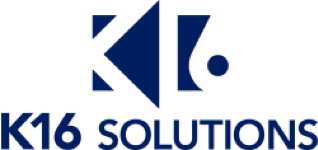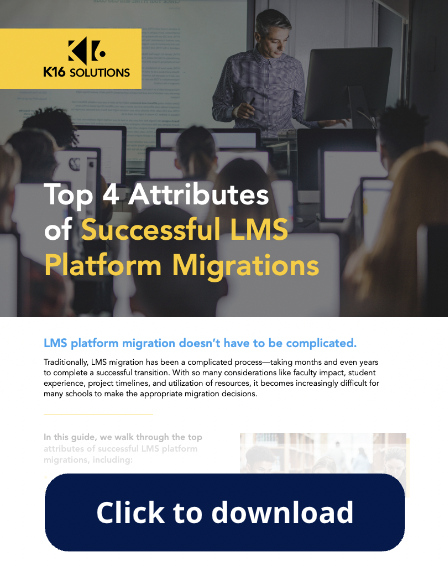Top 4 Attributes of Successful LMS Platform Migrations
LMS platform migration doesn’t have to be complicated.
Traditionally, LMS migration has been a complicated process—taking months and even years to complete a successful transition. With so many considerations like faculty impact, student experience, project timelines, and utilization of resources, it becomes increasingly difficult for many schools to make the appropriate migration decisions.
In this guide, we walk through the top attributes of successful LMS platform migrations, including:
- Automated Course Migration
- Speed-of-Delivery in Course Transfers
- Ready-to-Teach Courses (Accuracy in Course Transfers)
- Affordability
Whether you outsource your migration or have a dedicated instructional design department, switching to a new learning management system can be complex. But as online learning environments become essential in today’s educational landscape, it’s important to ensure that your LMS can support your institutional goals.
There are many reasons why your school may decide to switch LMS platforms. Whether your current software is out of date, too complex, or you’ve simply outgrown your current environment, it’s valuable to understand the process before you transition to a new system. With an automated migration tool, your new LMS environment is mapped out alongside your current system—allowing for an accurate and streamlined data transfer.
1. Automated course migration
Traditionally, course migration was a time and resource-intensive process, requiring hours of manual import, export, and cut-and-paste. The problem? With more human interaction comes more errors. This outdated process has long plagued the possibility of easy or accurate migrations, deterring many schools from attempting the process to begin with.
Fortunately, schools now have the ability to automate course migration from the ground up, giving both your instructional design team and faculty members more time and reduced stress.
With an automated course migration tool, you no longer have to transfer course content and user information manually. Course content—including tests, quizzes, and documents—seamlessly transfer into your new LMS automatically, eliminating the need for human intervention. And with a best-in class tool like Scaffold LMS Migration, your team will benefit from a simplified QA process with the ability to spot and remedy potential errors the moment they occur.
2. Accelerated timeline
When it comes to implementing a new LMS platform, there is a lot at stake. Not only are your faculty members depending on easy adoption of the new platform, but they are expecting improvements in overall system performance and outcomes. The longer an LMS migration drags on, the more it impacts students and faculty.
By replacing manual processes with automation, you can average about 5,000 course transfers per week.
Automation standardization allows you to simultaneously import and export hundreds of courses at one time, drastically reducing your migration timeline. Not only does this give free time back to your instructional design team and faculty members, but it ensures that students aren’t left dealing with two LMS platforms at once—saving your university time, money, and frustration.
“A list of robust courses was provided to K16, and not only were they migrated quickly, the content was placed in Canvas in a way that made the courses ready for immediate faculty use.”
Chris McLaughlin
Assistant Director
Wake Forest University
3. Ready-to-teach course delivery & accuracy
What happens when you couple automated migration with a simplified QA process? High-quality, read-to-teach courses.
By remedying concerns at the start of the process through automated standardization, you’re able to reduce the amount of manual clean-up required after the migration is complete. With an accurate data transfer, your faculty will benefit from seamless integration and highly accurate migration of tests, quizzes, assignments, and more.
With enhanced migration accuracy, faculty and professors will have instant access to all course content within the new LMS platform, eliminating the frustration involved with learning a new system. Rather than rebuilding their courses from the ground up, professors can focus on what matters—educating their students.
“K16 Solutions’ LMS migration solution saved a huge amount of work for faculty, eliminating the need for them to reconfigure and reformat their courses, content, quizzes, and other course materials. The consistency of the data and files that were migrated helped the CTL team to inform, train, and orientate faculty and staff on the new platform.”
Cebert Adamson
Mohawk College Dean of Continuing Education & Academic Quality
4. Cost savings
It’s no secret that LMS migrations are costly. As timelines shrink, the resources needed to support a migration will continue to drive up costs over time.
For most universities, there’s rarely downtime between semesters where migrations can successfully occur without interruption. As a result, staff and faculty must complete manual data transfers after-hours on top of their daily workload. With simultaneous import and export capabilities on an accelerated timeline, an automated migration tool can help you avoid indirect costs like labor and faculty involvement.
When you remove the need for human resources, you remove the need for spending unnecessary time and money on laborious tasks.
Scaffold Migration is the industry’s first cloud-native, fully integrated content migration service that puts your institution back in control of your LMS. With Scaffold LMS Migration, your course content moves in real time, capturing details such as course structure, quizzes, tests, and even question pools. Speak with an expert to learn more about what Scaffold Migration can do for your institution.



